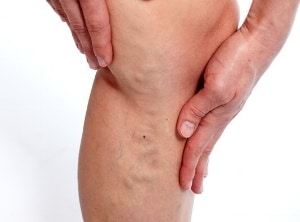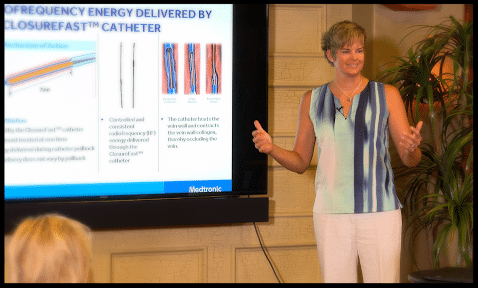
How to Treat Bleeding Varicose Vein and Bleeding Spider Veins
What can you do to treat bleeding varicose vein and spider veins?
First and foremost, don’t panic. Although the visual effect of a ruptured varicose vein or bleeding vein can be alarming, there are some simple things that can be done to get the bleeding to stop.
If you can reach the area that is bleeding, grab a tissue, wash cloth, towel, or whatever is handy and apply firm pressure. Hold the pressure for at least five minutes before “checking” to see if it has stopped. If you cannot reach the area, ask a family member, neighbor, or friend for help. Again, these bleeding veins look alarming but it would literally take several hours to “bleed to death” from a varicose vein rupture.
In addition to applying pressure, elevate the leg. If you don’t want to risk bleeding on the couch, bed, floor, throw a plastic bag underneath the area that is bleeding to protect fabric. A cold compress (ice, frozen peas, etc.) near the area that is bleeding will cause the blood vessels to constrict and help stop the bleeding. Finally, breathe. Slow deep breathing will help lower your blood pressure and heart rate which will help slow the bleeding.
Get a Full Vein Screening
It is important to have a lower extremity vascular evaluation. Bleeding veins can be a symptom of a larger vascular issue. There are vein treatment options which can eliminate bleeding varicosities, underlying venous problems, and the symptoms associated with them. Contact our vein specialist to schedule a complete venous evaluation and discuss appropriate treatment options.
After Bleeding Stops
One way to get blood out of clothing is to saturate the area in hydrogen peroxide. If you don’t have hydrogen peroxide handy, rinse the article in cold water and leave it damp until you can use the peroxide.
Is there anything worse than itchy varicose veins? Maybe, but itchy veins remains high on the list of issues we would love to resolve before they drive us crazy. If you are experiencing itching around your varicose veins, it could be a message from your body that it is time to have your veins checked…
Read MoreThe full story on Chronic Venous Insufficiency, what it is and how to treat it. A video presentation by Jilanne Rose, DNP-C, Clinical Director. Run Time 24:46. TRANSCRIPT What’s the Difference Between Veins and Arteries? When we talk about vascular health and vascular disease most people think about arteries. When we talk about the…
Read MoreA group of Gilbert Arizona Residents concerned about Chronic Venous Insufficiency gathered on Saturday July 16th for an interactive discussion on CVI symptoms, causes and treatments. Chronic Venous Insufficiency, Venous Reflux Disease and Varicose Veins affect over 30 million American men and women. Unfortunately, many do not get treated as they believe varicose veins are…
Read MoreCan Chronic Venous Insufficiency (CVI) be reversed? Unfortunately the short answer to this question is no; but CVI can be treated with minimally invasive procedures which can reduce symptoms and improve quality of life tremendously! Chronic Vein Insufficiency Causes In order to understand why venous insufficiency or peripheral venous insufficiency cannot be reversed, we must…
Read MoreWhat can you do to treat bleeding varicose vein and spider veins? First and foremost, don’t panic. Although the visual effect of a ruptured varicose vein or bleeding vein can be alarming, there are some simple things that can be done to get the bleeding to stop. If you can reach the area that is…
Read MoreWhy are varicose veins painful? The discomfort associated with varicose veins is caused by a combination of factors. When veins are weak, the blood which is supposed to return to the heart in a timely fashion, settles and pools in the superficial vein system. This pooling of blood worsens when patients stand or sit in…
Read MoreEndovenous Ablation Definition Taken literally, endovenous ablation is the removal of a vein from within. ‘Endo’ means internal or inside, ‘venous’ refers to a vein, and ablation is to ‘remove’. In the instance of veins, it is no longer necessary to physically remove a vein from the leg (vein stripping) to improve symptoms or the…
Read MoreThe newest procedure for the treatment of varicose veins was approved by the FDA about two years ago. It is what has been termed a non-tumescent non-thermal therapy. What this means is that it does not require a lot of numbing medicine to complete, and it does not use a heating element to close or…
Read MoreWhat is the best treatment for varicose veins? No varicose vein is the same; no person’s symptoms are the same; and so the best procedure for varicose veins is not always the same. The treatments associated with vein disease are based on a patient’s symptoms, vein size, location, contributing conditions, and ultrasound findings. Different…
Read More
